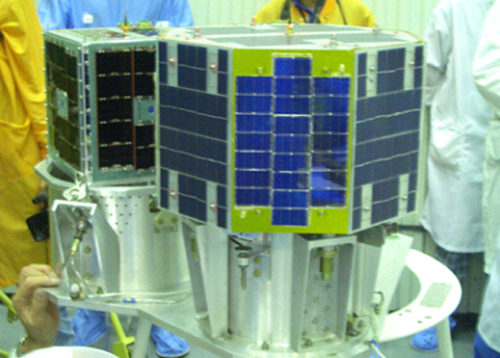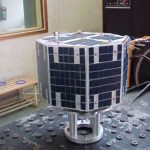UniSat-3 is the third student-made microsatellite, designed, integrated, tested and operated in orbit by the students participating in the UNISAT Program established at the Scuola di Ingegneria Aerospaziale of Università di Roma “La Sapienza” by the research Group GAUSS (Gruppo di Astrodinamica dell’Università degli Studi “La Sapienza”).

The scientific satellite UniSat-3 during the integration phase
Characteristics
- Modular architecture of the spacecraft consists of an octagonal prism 40cm diameter and 25cm height with 150 x 250mm octagonal plates and alluminium panels, nominal mass of 12 kg
- Sun-synchronous orbit, height 710/790 km, inclination 98°
- Spacecraft stabilized with a passive magnetic attitude control: attitude stabilization was performed by a permanent magnet and attitude determination through a Sun sensor
- Affordable budget for the realization
- Subsystems off the shelf, like CDH, computer and stacked telemetry electronic boards
- Solar panels for Power subsystem and Solar Cells Tests (constructed by the Kiev Polytechnic Institute)
- Communication system conform to the radio amateur packet system.
Mission Objectives
- As the previous two prototypes, “hands-on” education and research are the main goals: providing the students (with the support of the University staff) with more practical experience and didactical effectiveness
- In-orbit Testing and Space qualification of terrestrial off the shelf components and technologies
- Foster cooperation between Universities and Companies/Industries concerning Space activities
- Measurements of the Earth magnetic field for attitude determination
- Test of telecommunications: telemetry correctly received from the SPIV Ground Station right after launch.
Payloads on board
- Electronic boards
- COTS magnetometer (mounted on a PCB – Printed Circuit Board)
- Triple junction solar cells (Photovoltaic system)
The Launch
UniSat-3 was successfully launched on 29 June 2004 from Baikonur Cosmodrome using the DNEPR launch vehicle, only 18 month after UniSat-2 launch and lasted/was tracked for over 5 years in orbit.
It was a cluster launch with other seven satellites: SaudiComsat 1, SaudiComsat 2 and SaudiSat 2 from Saudi Arabia (KACST); AprizeSat 1 (LatinSat C), AprizeSat 2 (LatinaSat D) and AmSat Echo from United States (SpaceQuest); Demeter from France (CNES).

UniSat-3 Spacecraft
